London vs. Boston Rentals: How Residential Tech Differs U.K.-U.S.
| . Posted in News - 3 Comments
By Douglas Quattrochi, Executive Director
I’m fortunate to have spent a fair bit of time in London, where I have family. There are differences between a rental in London and a rental in Boston. It’s more than just calling it an “apartment” in Boston vs. a “flat” in London. Here are my two cents on what’s better and worse about Massachusetts. This may be useful for policy makers, travelers or landlords looking to differentiate their units. Or maybe you’re just curious. Either way, here are the big differences between U.S. apartments and U.K. flats.
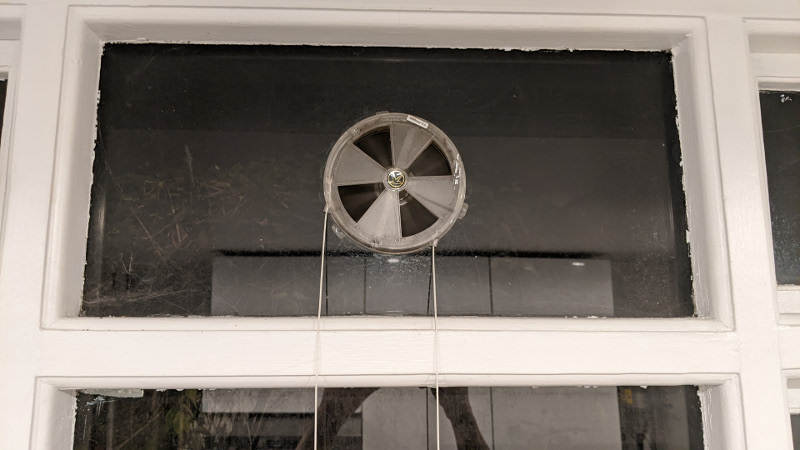
This U.K. window vent is a plastic circle cut into the glass pane with six fins. The fins can be closed by pulling on the string. In colder climates like Massachusetts, we wouldn’t dream of doing this. CC BY-SA 4.0 MassLandlords, Inc.
Insulation and Air Sealing in the U.S.
Massachusetts winters are cold. So cold, in fact, that we can’t mess about with shoddy insulation or leaky windows. It’s common in Massachusetts to use spray foam in new construction. We have Mass Save programs to retrofit blow-in insulation. Our sanitary code prohibits window gaps larger than one-sixteenth of an inch, and most people would consider any gap at all worth sealing.
Not so in the U.K. In London, in particular, temperature extremes are dampened by the Gulf Stream, which has historically kept summers cool and winters warm. Visitors to London’s public gardens or certain sections along the Thames might be astonished to see palms year-round, as I was when I first visited.
There are times when London gets oppressively hot, like summer 2022. And there are times when it snows, like winter 2022-2023. But these temperature extremes are historical anomalies. If climate change is destabilizing the Gulf Stream, that would explain why London is seeing unusual weather. But historically, there has been very little need for insulation and air sealing.
Weather stripping a London door often means nailing a bar of wood with a triangular cross-section across the kick.
Windows often have plastic ventilation holes cut through the panes of glass, with plastic spinner vents inserted. When closed, the vents stop bugs but only slow down escaping warm air.
On Demand Water Heat with Panel Radiators in the U.K.
In Massachusetts, it’s customary to look at domestic hot water as a different system from space heating. We can have combination boilers and furnaces, true. But in rentals, we’ll commonly see tank water heaters and a dedicated space heater (boiler to hydronic baseboards, furnace to ducting, etc.).
In London, it’s customary to have a single on-demand water heater run both a set of hydronic panel radiators and the domestic hot water. This saves on space in a small flat.
The use of panel radiators is a big climate advantage over Massachusetts. Panel radiators work with lower water temperatures (typically 120 F) than our finned baseboards (typically designed for 180 F). This makes the U.K. more ready to replace combustion with heat pump technology. In the U.S., if and when a boiler needs to be swapped out with an air- or ground-to-water heat pump, we will likely need to swap out our baseboards for U.K.-style panel radiators. Or else we will need higher temperature heat pumps than are available at the moment.
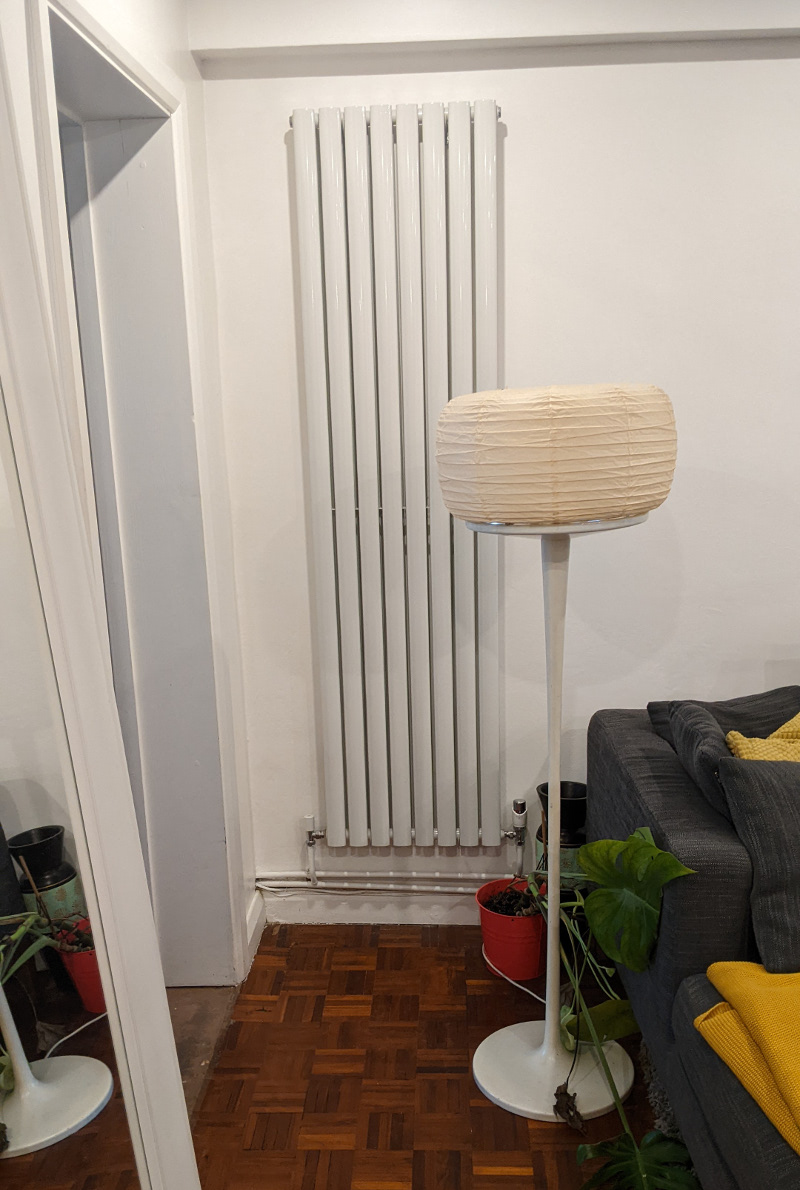
U.K.-style panel radiators are unlike anything we have in the U.S. This seven-foot tall panel radiator radiatively and convectively heats a 300 square foot living room, and wilts a houseplant placed unfortunately close to it. CC BY-SA 4.0 MassLandlords, Inc.
HVAC Comfort in the U.S.
It’s increasingly common in the U.S. to have air conditioning in a rental. We need it for our hot, muggy summers. Even if it’s only a window unit, lots of apartments now accommodate air cooling.
It’s rare in the U.K. to find air conditioning. Historically, it hasn’t been needed. Masonry construction, especially in London, gives a higher thermal mass to walls than our wood-frame construction. Still, it gets warm in London in the summer now. U.K. flats often sport six-foot wide, wood frame behemoth windows, or else get retrofitted into casements. Neither works well with what we think of as a conventional U.S. window air conditioner. Heat pumps are used but are not widespread yet.
It’s rare in the U.K. to have a central thermostat even for heat. Most of the heat is controlled at the radiator itself, without reference to a temperature scale in degrees. (Settings include “snowflake” and the numbers 1 through 5.) Where there is a central thermostat, it’s often a wireless retrofit to the existing on-demand heater.
Lastly, the U.K. sometimes has load shifting on water tanks. The basic idea is to heat the water at a time when the grid is not in high demand (e.g., 4 a.m.). Unfortunately, this means you might not have hot water when you expect. The solution is to find the tank timer, set it to “boost” mode, and wait an hour.
For these reasons, the U.S. is ahead on comfort overall.
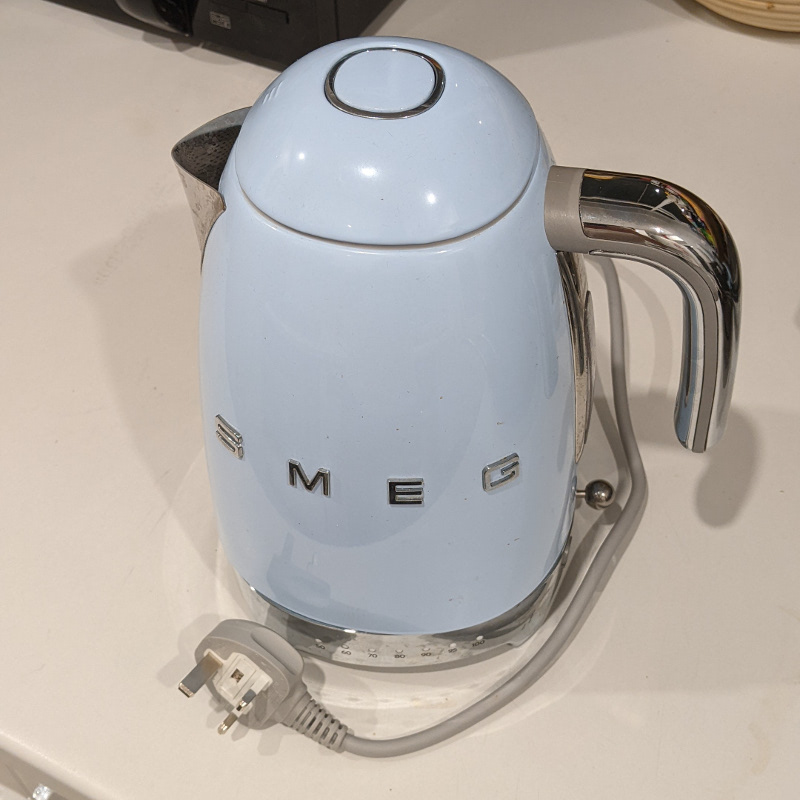
U.K. plugs have received a substantially greater amount of engineering attention than U.S. plugs. It is much less likely to electrocute yourself or start a fire, despite increased voltage. Tea kettles boil water nearly instantly. CC BY-SA 4.0 MassLandlords, Inc.
Real Electricity in the U.K.
The U.K. electrical grid, like most of the planet outside the U.S., operates on a base residential voltage of 230 volts. This gives appliances roughly twice the potential to do work compared to the U.S. grid, which is at 120 volts. A U.K. toaster will have made its first piece of toast by the time a U.S. toaster is glowing. A U.K. electric tea kettle will be steeping your tea before a U.S. kettle is starting to hiss.
Of course, this raises interesting safety questions in bathrooms. Higher voltage means greater potential for arcing across the air, into your fingertips and out through your wet feet.
U.K. bathrooms are divided by electrical code into zones. Zone 0 is the area defined by a cube encompassing the toilet, shower, tub and sink. Inside Zone 0 there can be no 230 V electrical outlet or switch. Zone 1 is above this cube. Zone 2 includes any space above Zone 1 and beside Zone 0.
Bathrooms built or renovated before 2008 cannot have a 230 volt fixture in any zone. Since 2008, 230 volt fixtures have been allowed in Zones 1 and 2 provided they are waterproof to certain standards and have residual current breakers (ground fault circuit interrupters or “GFCI”).
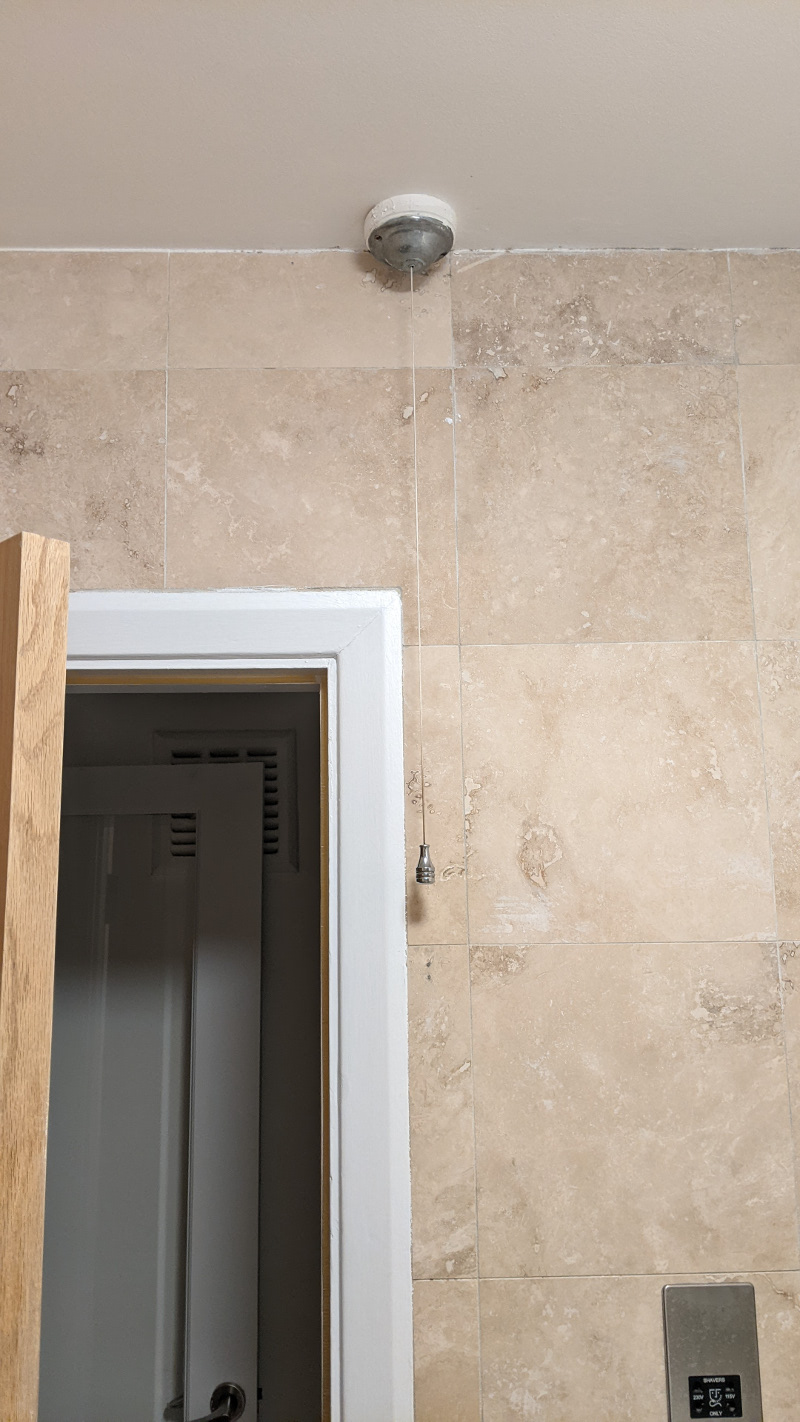
This U.K. ceiling pullchain controls the bathroom lights. It is a fairly common safety feature to have high voltage fixtures away from water. CC BY-SA 4.0 MassLandlords, Inc.
All this means your typical U.K. bathroom will have its light switch outside or else controlled by string from the ceiling. The sole outlet will be a dual-voltage shaver charger which, for reasons unclear to me, offers ungrounded 115- and 230-volt receptacles. The 115 volt half of the shaver charger is like a small gift to U.S. visitors, as it’s the only place in the flat you can insert ungrounded U.S. electronics without a voltage or plug adapter.
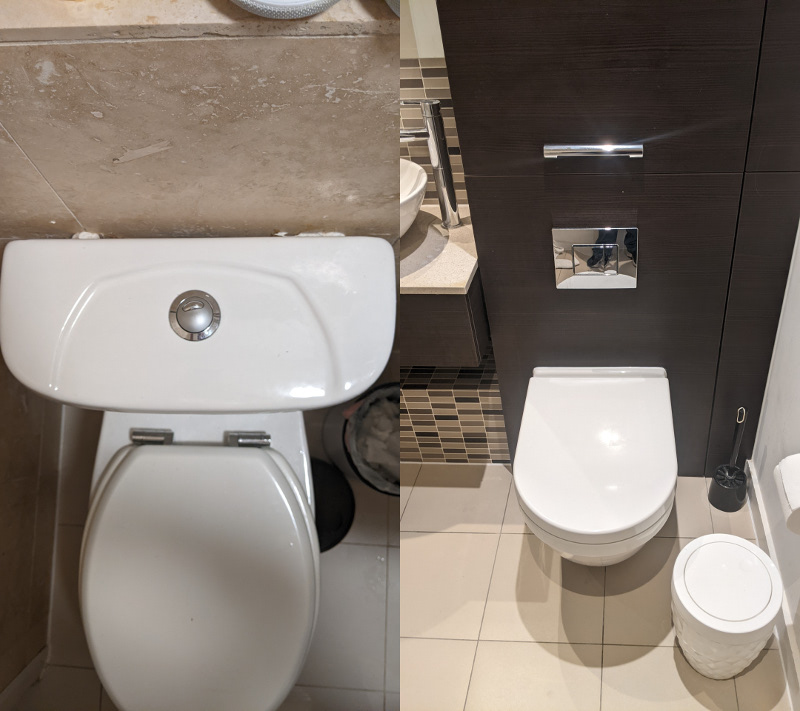
The U.K. is ahead of the U.S. on water conservation. All recently installed toilets have a dual flush setting, which can use the right amount of water for the task at hand. CC BY-SA 4.0 MassLandlords, Inc.
Water Conservation and Flexible Showering in the U.K.
For a long time now, all U.K. toilets have been installed with select-a-size flush. There’s a smaller button for number one and a larger button you can press at the same time for number two. The design of a U.K. toilet is overall very friendly to conservationists as it uses minimal water and has only a momentary siphon even on full flush.
U.K. showers are also a lot more direct. It’s common to have a handheld attachment, or to be able to remove the showerhead, to position it up high if you’re tall or down low as suits your purpose.

U.K. showers can be either more efficient or fun or both, depending on your perspective. Handheld shower sprayers are common in the U.K. CC BY-SA 4.0 MassLandlords, Inc.
Both the U.S. and the U.K. still exhibit a lot of separate faucets or taps for hot and cold water. Few people wash their hands by plugging the sink basin and mixing the output of both taps, so this is antiquated in both places.

Hot water runs through this UK-style towel rail and bathroom heater. The bathroom stays warm. Towels stay hygienically dry. CC BY-SA 4.0 MassLandlords, Inc.
Heated Towel Rails in the U.K.
The heated towel rail is by far the best thing about U.K. flats. Imagine a chrome shower curtain rod remade as a ladder and full of circulating hot water from the panel radiators. (Sometimes they’re electric instead of hydronic.) Your hand towel, shower towel or all the towels can hang on the warm ladder rungs.
Having a warm towel is nice, for sure, but this is not just a pleasantry. Heated towels are a hygiene improvement over U.S. standards. How many times have you visited friends or a tenant in the U.S. and seen, to your horror, a sopping wet hand towel? We really put a lot of faith in our handwashing techniques! In the U.K., they just cook the towel until all the moisture-loving bacteria and viruses are dead. Each use is of a relatively clean towel.
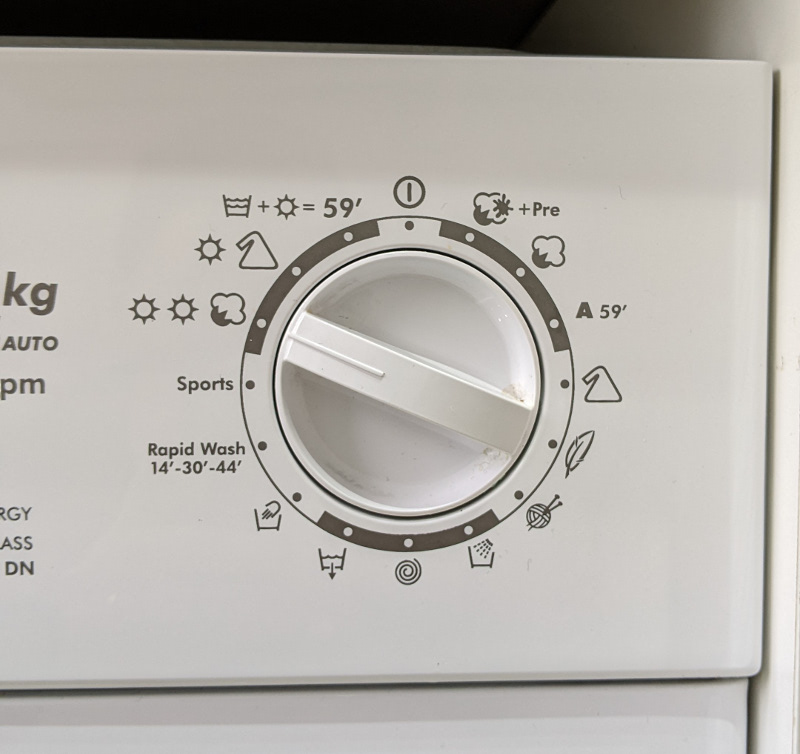
One side-effect of multicultural Europe is that appliances tend to use language-agnostic markings so they can be sold in multiple countries. This combination washing machine and condensor dryer is set to “two sunshines and a popover,” whatever that does. CC BY-SA 4.0 MassLandlords, Inc.
Real Kitchen Appliances in the U.S.
In the U.S., our stoves are often freestanding and large enough to cook multiple things at the same time. Our dryers are large tumble dryers that match the capacity of our washers. And our refrigerators have enough internal machinery to keep things cold without freezing the back.
Appliances in the U.K., however – in London, in particular – are held back by smaller kitchen sizes.
Washing machines are usually dual-purpose dryers. Although space efficient, this tends to mean that you can wash twice as much as you can dry in one go. Americans expecting a full load of wash to come out dry will be disappointed, because we don’t realize U.S. washer-dryers that come in a set will have a dryer with twice the drum volume as its paired washer. Condenser dryers in the U.K. are therefore damp experiences for the uninitiated. It’s common for London flats to have a clothes drying rack to dry your clothes to completion after they come out of the dryer steaming.
Fridges are usually not big enough to separate the cooling panel from the food storage area. This means it’s common to experience food freezing everywhere, not just in the freezer, if loaded quickly.
London water is higher in mineral content, so lime scale is a recurring issue with tea kettles and sinks. I have never seen an ice maker in the U.K.; this may be why.
Better Bug Protection in the U.S.
In Massachusetts, the sanitary code requires window screens during mosquito season. This is a public health measure. The U.K. has mosquitos, too, but it’s rare to see window screens. I will say, there is no visible presence of mosquitoes in London, because standing water is managed out of existence relative to population density. The mosquitoes there are bothering someone else.

By raising bollards and closing this intersection to vehicles, bikers prefer to get off the nearby thoroughfare and onto this side road. The result is smoother and safer traffic flow for bikers and drivers alike, albeit on separate routes. CC BY-SA 4.0 Oliver Chadwick and MassLandlords, Inc.
Better Street Access in the U.K.
The U.K. – London especially – is much easier to get around in than Massachusetts. For starters, greater London is 10 times bigger than Boston by population, and the subway (tube) network has been invested in 10 times more wisely, it would seem. The two combined make London’s subway far safer and more useful than the MBTA. (That is, unless you have a physical disability, in which case, God bless the Americans with Disabilities Act. The London tube is impassably stair bound by U.S. standards.)
Even if you prefer not to take the rail, biking is paradise in London. Dedicated bike lanes and bike-only intersections make biking faster than car travel for most trips in the one- to six-mile range. A citywide vehicle speed limit of 20 mph makes biking feel safe even in the case of a bike lane running out. Bike lights let bikes get into the intersection to take a right turn (as hard as turning left in the U.S.) before cars start. And the ability to buy or rent an electric box bike allows you to carry around even furniture without a car. If the U.S. had this level of bike infrastructure, the number of parking spaces that came with an apartment would hardly matter.
London Likes Keys
The final difference between a London flat and a Boston apartment is the likelihood of having physical keys. In Massachusetts, especially with short-term rentals, it’s very common to get a keypad password to access an apartment. In London, it’s all about the keys. Surprisingly, mortise locks with “jailor key” style access are still common for individual unit doors past the common area.
U.S. Apartment vs U.K. Flat Summary
Those are the things I’ve noticed having lived and worked in Boston and Worcester, and having spent far less time (but still a lot of time) in London. Have you noticed the U.S. is ahead of or behind a place you frequent? (India and Italy visitors, tell us about bidets!) Let us know what you think by emailing hello@masslandlords.net.




